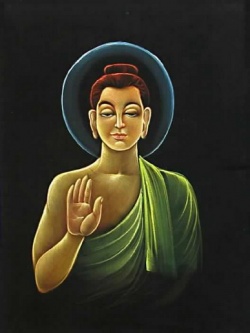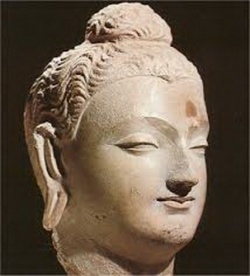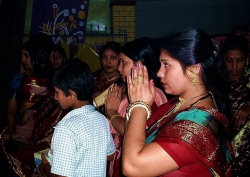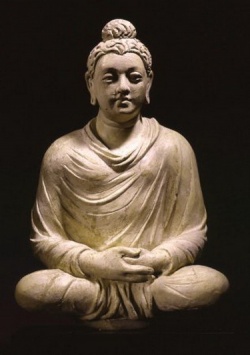Out on a Limb
The venerable Sariputra then asked the Buddha, “Lord, in which buddha-field did the noble Vimalakirti die, before reincarnating in this buddha-field?” The Buddha said, “Sariputra, ask this good man directly where he died to reincarnate here.” Then the venerable Sariputra asked the Licchavi Vimalakirti, “Noble sir, where did you die to reincarnate here?” Vimalakirti declared, “Is there anything among the things that you see, elder, that dies or is reborn?” Sariputra: There is nothing that dies or is reborn. Vimalakirti: Likewise, reverend Sariputra, as all things neither die nor are reborn, why do you ask, “Where did you die to reincarnate here?” Reverend Sariputra, if one were to ask a man or woman created by a magician where he or she had died to reincarnate there, what do you think he or she would answer? Sariputra: Noble sir, a magical creation does not die, nor is it reborn. Vimalakirti: Reverend Sariputra, did not the Tathagata declare that all things have the nature of a magical creation? Sariputra: Yes, noble sir, that is indeed so. Vimalakirti: Reverend Sariputra, “death” is an end of performance, and “rebirth” is the continuation of performance. But, although a bodhisattva dies, he does not put an end to the performance of the roots of virtue, and although he is reborn, he does not adhere to the continuation of sin.
Śāriputra is essentially asking Vimalakirti, “What was your former-life before this one?” Vimalakirti reminds him that even within his own dharma-ken that there is neither birth nor death—birthlessness. If that is indeed his foundation, then why even ask a silly question like “what was your former-birth like”, it’s like asking a phantom-mirage “what is your parentage?” Vimalakirti also asserts that apparent death is the end of a soma’s performance; rebirth is a perpetual re-genesis of that performance. The Bodhisattva, although donning the sheath of death is not extinguished; by the same token, while entering into the re-genesis for the sake of sentient beings is not held-bound by it.
Then, the Buddha said to the venerable Sariputra, “Sariputra, this holy person came here from the presence of the Tathagata Aksobhya in the universe Abhirati.”
Sariputra: Lord, it is wonderful that this holy person, having left a buddha-field as pure as
Abhirati, should enjoy a buddha-field as full of defects as this Saha universe!
The Licchavi Vimalakirti said, “Sariputra, what do you think? Does the light of the sun
accompany the darkness?”
Sariputra: Certainly not, noble sir!
Vimalakirti: Then the two do not go together?
Sariputra: Noble sir, those two do not go together. As soon as the sun rises, all darkness
is destroyed.
Vimalakirti: Then why does the sun rise over the world?
Sariputra: It rises to illuminate the world, and to eliminate the darkness.
Vimalakirti: Just in the same way, reverend Sariputra, the bodhisattva reincarnates
voluntarily in the impure buddha-fields in order to purify the living beings, in
order to make the light of wisdom shine, and in order to clear away the darkness.
Since they do not associate with the passions, they dispel the darkness of the
passions of all living beings.
We now discover that Vimalakirti heralds from the “universe Abhirati”—he emanates from a Buddha-field that is like a brilliant realm of light compared to the eternal darkness of this saha-realm. (more on the significance of his origin is forthcoming). Vimalakirti enlightens Śāriputra that the Way of the Bodhisattva Illumines the darkened dungeon-realm of beings deprived of the salfivic light of the Sugata—thus scattering the impounded-dark passions of sentient beings like the first rays of dawn dispelling the night.
Thereupon, the entire multitude experienced the desire to behold the universe Abhirati, the Tathagata Aksobhya, his bodhisattvas, and his great disciples. The Buddha, knowing the thoughts of the entire multitude, said to the Licchavi Vimalakirti, “Noble son, this multitude wishes to behold the universe Abhirati and the Tathagata Aksobhya – show them!”
Then the Licchavi Vimalakirti thought, “Without rising from my couch, I shall pick up in my right hand the universe Abhirati and all it contains: its hundreds of thousands of bodhisattvas; its abodes of devas, nagas, yaksas, gandharvas, and asuras,bounded by its Cakravada mountains; its rivers, lakes, fountains, streams, oceans, and other bodies of water; its Mount Sumeru and other hills and mountain ranges; its moon, its sun, and its stars; its devas, nagas, yaksas, gandharvas, and asuras themselves; its Brahma and his retinues; its villages, cities, towns, provinces, kingdoms, men, women, and houses; its bodhisattvas; its disciples; the tree of enlightenment of the Tathagata Aksobhya; and the Tathagata Aksobhya himself, seated in the middle of an assembly vast as an ocean, teaching the Dharma. Also the lotuses that accomplish the buddha-work among the living beings; the three jeweled ladders that rise from its earth to its Trayastrimsa heaven, on which ladders the gods of that heaven descend to the world to see, honor, and serve the Tathagata Aksobhya and to hear the Dharma, and on which the men of the earth climb to the Trayastrimsa heaven to visit those gods. Like a potter with his wheel, I will reduce that universe Abhirati, with its store of innumerable virtues, from its watery base up to its Akanistha heaven, to a minute size and, carrying it gently like a garland of flowers, will bring it to this Saha universe and will show it to the multitudes.”
Then, the Licchavi Vimalakirti entered into a concentrationd performed a miraculous feat such that he reduced the universe Abhirati to a minute size, and took it with his right hand, and brought it into this Saha universe. In that universe Abhirati, the disciples, bodhisattvas, and those among gods and men who possessed the superknowledge of the divine eye all cried out, “Lord, we are being carried away! Sugata, we are being carried off! Protect us, O Tathagata!” But, to discipline them, the Tathagata Aksobhya said to them, “You are being carried off by the bodhisattva Vimalakirti. It is not my affair.”
As for the other men and gods, they had no awareness at all that they were being carried anywhere. Although the universe Abhirati had been brought into the universe Saha, the Saha universe was not increased or diminished; it was neither compressed nor obstructed. Nor was the universe Abhirati reduced internally, and both universes appeared to be the same as they had ever been. Thereupon, the Buddha Sakyamuni asked all the multitudes, “Friends, behold the splendors of the universe Abhirati, the Tathagata Aksobhya, the array of his buddhafield, and the splendors of these disciples and bodhisattvas!”
They replied, “We see them, Lord!”
The Buddha said, “Those bodhisattvas who wish to embrace such a buddha-field should train themselves in all the bodhisattva-practices of the Tathagata Aksobhya.” While Vimalakirti, with his miraculous power, showed them thus the universe Abhirati and the Tathagata Aksobhya, one hundred and forty thousand living beings among the men and gods of the Saha universe conceived the spirit of unexcelled, perfect enlightenment, and all of them formed a prayer to be reborn in the universe Abhirati. And the Buddha prophesied that in the future all would be reborn in the universe Abhirati. And the Licchavi Vimalakirti, having thus developed all the living beings who could thereby be developed, returned the universe Abhirati exactly to its former place.
At this junction, I would like to interject a theory—going out on a limb—as to the singular nature of just who this Vimalakirti really is. Indeed, is he merely an “ordinary enlightened-being” as many throughout the millennium have indomitably asserted? A spectacle that the ordinary-person would like to emulate? I believe the evidence has shown throughout this study of the Vimalakirti Sutra that the singular-ability behind this noble-Maha Bodhisattva—all of the stupendous miraculous occurrences (present one above included)—equaled only by the stature of a Tathagata, that Vimalakirti is non-other than the manomayakāya of the Tathagata Aksobhya from the Universe Abhirati. Even though Aksobhya (like Odin pulling the wool over the eyes of the denizens of his own kingdom—appearing as something or someone “other” than himself) responds to the inhabitants of that universe as they are being mystically transported, “You are being carried off by the bodhisattva Vimalakirti. It is not my affair.” What’s to prevent a Tathagata from donning the mystical garb of a manomayakāya (Mind-made manifestation—for a full breakdown of the term, please search within the archives, in particular the Lanka series) in order to edify the resolve of Bodhisattvas who hunger for the full flavor of Tathagatahood? If nothing else, there is truly no other Maha-Bodhisattva that can be likened to Vimalakirti. Clearly all of the bodhisattvas, gods, goddesses, nagas, disciples, et cetera within this sutra have been edified to the nth degree by Vimalakirti—without question an “extraordinary” feat! Or, if you prefer, a Bodhi-being doing extraordinary things through ordinary means—the paramārtha (absolute truth) revealed through samvrti (conventionality).
The Lord then said to the venerable Sariputra, “Sariputra, did you see that universe Abhirati, and the Tathagata Aksobhya?” Sariputra replied, “I saw it, Lord! May all living beings come to live in a buddhafield as splendid as that! May all living beings come to have miraculous powers just like those of the noble Licchavi Vimalakirti!
“We have gained great benefit from having seen a holy man such as he. We have gained a great benefit from having heard such teaching of the Dharma, whether the Tathagata himself still actually exists or whether he has already attained ultimate liberation. Hence, there is no need to mention the great benefit for those who, having heard it, believe it, rely on it, embrace it, remember it, read it, and penetrate to its depth; and, having found faith in it, teach, recite, and show it to others and apply themselves to the yoga of meditation upon its teaching. “Those living beings who understand correctly this teaching of the Dharma will obtain the treasury of the jewels of the Dharma.
“Those who study correctly this teaching of the Dharma will become the companions of the Tathagata. Those who honor and serve the adepts of this doctrine will be the true protectors of the Dharma. Those who write, teach, and worship this teaching of the Dharma will be visited by the Tathagata in their homes. Those who take pleasure in this teaching of the Dharma will embrace all merits. Those who teach it to others, whether it be no more than a single stanza of four lines, or a single summary phrase from this teaching of the Dharma, will be performing the great Dharma-sacrifice. And those who devote to this teaching of the Dharma their tolerance, their zeal, their intelligence, their discernment, their vision, and their aspirations, thereby become subject to the prophesy of future Buddhahood!”
Having been portrayed mostly as the mouthpiece for conventionalism throughout this sutra, it is refreshing to see Śāriputra taking his stature again as a renowned one in the Buddhadharma—showering his gratitude upon Vimalakirti and relaying the auspicious benefits of this sutra for anyone who pays it homage. Anyone who sincerely takes his homage to heart will surely be meritoriously touched.



